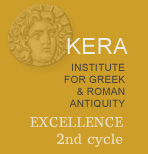Elmalı Yurt / Pırnaz
58. Epitaph of Meis and her family
![]()
5 10 15 |
Καλλικλῆς Κό– μωνος Ἐφέσ̣ου ἀνέστησεν ἑαυ– τὸν λέοντα καὶ τ– ὴν γυναῖκα Τατα– ν Κλεάρχου ἀγάλματι καὶ θυγατέρα αὐτοῦ Μειν τετελευτηκ̣υ[ί]– α ἀγάλματι [μ]νή– μης ἕνεκεν. Εὐοχη– θήσονται δὲ καθ' ἔ[τ]ο– ς καὶ θυσιάσουσιν οἱ κληρονόμοι μου ἐν μηνὶ Ἀρτεμεισίῳ. |
Kallikles, son of Comon [(the judge?)], raised for himself a lion10 and for his wife Tata, daughter of Κlearchos, a statue, and for his daughter Meis who has passed away, a statue, in memory. My heirs will feast and sacrifice every year in the month Artemision.
Fluted funerary column with tabula ansata. The inscription's last three lines exceed the tabula and are inscribed below its frame. Found by Collignon in 1876 and published in 1879, it was first seen again by Naour and republished with some new readings in 1977. In 2004, the stone served to support a wire-mesh fence at the cemetery of Elmalı Yurt (previously Pırnaz).
Height: at least 106 cm; diameter: ca 48 cm; letters: 2-3 cm. The dimensions of the tabula are approximetely 38x38 cm. I don't see why the letter forms of this inscription need be any later than those of most other funerary columns from the area, though Collignon (1879), p. 39, writes that they "accuse une époque assez basse" and Schindler speaks even of "sehr späten Buchstaben" (but evidently without having seen the stone). The monument, or at least the inscription, must date to imperial times.
Collignon 1879, pp. 39-40, no. 1; Robert 1937, pp. 391-398; Robert, BullÉp 1938, no. 440; Schindler 1972, no. 31; BullÉp 1973, no. 461; Naour 1977, pp. 279-280 no. 7 (pl. IX.7: photograph); SEG 27 (1977), no. 928; Milner 1998, p. 4, no. 4.3.
L. 1-2 : Καλλικλῆς: see no. 72. Robert 1937, p. 392 notes that Κόμων appears to be diffused in Pisidia (see IK Selge 22; MAMA 8 394; Ramsay 1897, p. 337, no. 174; p. 338, no. 180; p. 339, no. 189; SEG 2 [1924], no. 717; 6 [1932], no. 605; 14 [1957], no. 797; 19 [1963], no. 816). It seems to be common on Rhodes also: IG XII 1 4, ll. 30, 50, 57, 60; 1.46, l. 316; 1.73; Segre and Pugliese Carratelli 1952, no. 38, col. I, l. 11; Pugliese Carratelli 1957, p. 165, no. 16, l. 30; SEG 39 (1989), no. 732. In Boubon, it may be attested also in no. 28. Αfter Κόμωνος, Robert reads ΕΦΕΤΟΥ, based on a copy by Holleaux. Based on his own inspection of the stone, Naour reads Ἐφέσου. The surface of the stone is worn, and though we made a separate squeeze of this particular section, I can only tentatively confirm Naour's reading. Following ΕΦΕ there may indeed be a square sigma, but the T read by Holleaux, or in fact a Ξ cannot be entirely excluded. The fact however that Ἔφεσος is an attested male name speaks for a sigma, while Ἐφέτης, meaning a judge of cases of homocide in classical Athens, seems highly unlikely in this context, and ΕΞΕΤΟΥ can't be made sense of at all. In fact this Κόμων Ἐφέσου is most likely identical with a man in an inscription from Dereköy south of Boubon: Wörrle and Wurster 1997, col. B I, l. 56. For the name Ἔφεσος cf. IG II 21297, l. 34 (Athens); Buckler and Robinson 1932, no. 1, col. I, l. 17; SEG 35 (1985), no 1255 (both Lydia); IK Ephesos 2, l. 38 and 45; IG XII, 8 140 (Imbros).
L. 3-4 : On funerary monuments including sculptural representations of lions see Robert 1937, pp. 391-398 and no. 35. See also no. 35 on the name of the deceased placed in the accusative case.
L. 4-6 : The female name Τατα is found in most regions of Asia Minor: Zgusta 1964, no. 1517.1. For Pisidia cf. Ramsay 1897, p. 333, no. 146; p. 333, no. 147; SEG 19 (1963), no. 760. For Lycia cf. TAM II 15; 17; 534; 616 (l. 15); 953 (l. 4); 1164; Bean 1971, no. 40; SEG 44 (1994), no. 1211; In IK Kibyra I the name is attested only once (no. 238). On this and its variants, Τατεις, Τατας etc. (Zgusta 1964, nos. 1517.17; 1517.21), see Milner 1998, p. 4. They are commonly taken for epichoric, but as "Lallnamen" they are not confined to the Anatolian languages; cf. Robert 1963, p. 348; Kretschmer 1896, p. 348. On Κλέαρχος, see no. 72 and no. 31.
L. 8 : Μεις is a form of the name of the male Anatolian moon-god Men, but is also attested as a female name of local origin (cf. Zgusta, op. cit., 891.2). Examples in inscriptions from Lycia include TAM II 144; Naour 1977, no. 10.
L. 9 : τετελευτηκυία must represent an accusative missing the final nu, as opposed to a dative, because both θυγατέρα and Μειν are in the accusative case.
L. 10-15 : An obligation to perform annual offerings and to hold feasts in memory of the deceased is usually included in the terms of a foundation established in the tomb owner's will (Robert 1937, p. 391). The date on which such rites were to take place could be either an annual religious festival or another date chosen by the tomb owner, for example his birthday (cf. Hotz 2005, pp. 166-167; Kokkinia 1999, pp. 212-213).
It appears that Kallikles raised this funerary monument following the death of his daughter Meis. Though neither he nor his wife are referred to in the inscription as ζῶν or ζῶσα respectively (ἑαυτὸν λέοντα ζῶντα and τὴν γυναῖκα Τάταν Κλεάρχου ἀγάλματι ζῶσαν), it seems safe to assume that the indication τετελευτηκυία(ν) which follows the name of the daughter is meant to distinguish between the deceased and the living at the time when the monument was raised. Cf. the commentary on no. 39.

